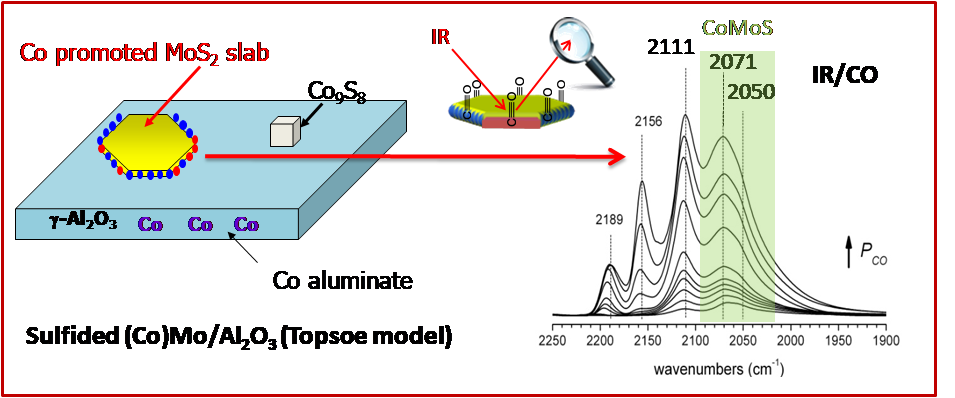From in situ to operando spectroscopic study of sulfide catalysts for hydrotreating reactions and electrocatalytic applications.
PhD supervisors : Laetitia Oliviero and Françoise MAUGÉ
Laboratoire Catalyse et Spectrochimie (LCS) (https://www.lcs.ensicaen.fr)
Unicaen, ENSICAEN, Université de Caen, CNRS
6, Boulevard Maréchal Juin 14050 CAEN FRANCE

The laboratory Catalyse et Spectrochimie (LCS), CNRS – University of Caen (France) has a strong recognition in vibrational spectroscopy for the study of catalytic surfaces. LCS has a fleet of twenty spectrometers equipped for studies in in situ conditions (spectroscopic study under model atmosphere) or operando conditions (spectroscopic study during the catalytic reaction). The LCS has a long expertise in the study of sulfide catalysts for hydrotreating based on IR spectroscopy of adsorbed CO on sulfide catalysts and HDS and HDN catalytic tests. These studies can account for the nature, concentration and environment of the active sites of the sulfide catalysts as well as for their activity and functionalities through parallel with the catalytic performances. Hence, LCS recently points out that a controlled design of the morphology of the sulfide catalyst allowed a 2-fold increase of its HDS activity.
The PhD subject will present two parts:
- Characterization of the sulfide catalysts in presence of a liquid phase. Up to now, the characterization of sulfide catalysts by IR/CO was carried out after in-situ gas phase sulfidation or ex-situ liquid phase sulfidation. In an attempt to bridge the gap between academic study and industrial applications, we aim to develop a methodology to probe the active sites in presence of a liquid in an Attenuated Total Reflection cell with circulation flow and probe introduction. This would allow to go further on the comparison between the sulfidation processes. It will also open the route for characterization of sulfide catalysts in an electrocatalytic cell
- IR study of sulfide catalysts in operando conditions. An operando study will be launched in parallel to the previous part. The IR characterizations of sulfide catalysts are all being conducted in in situ conditions i.e. in models conditions: in situ sulfidation under flow of H2S/H2 at high temperature and high pressure with spectroscopic study under vacuum. To go further and reach a real knowledge of the catalyst sites in reaction conditions, an important development is to move towards operando study of sulfide catalyst i.e. spectroscopic study in HDS reaction conditions (or other reaction). The objective is to simultaneously conduct analysis of the catalyst surface species and measurement of the catalytic performances. Operando study of sulfide catalyst is a real spectroscopic challenge (related to the very low signal to noise ratio of the catalyst) as well as technological one (strict control of H2S leaks as well as oxygen and water contamination in the IR-reactor cell,…). The technical aspect of this highly innovative development will be conducted with the support of the spectroscopic platform staff. However, the novelty (few operando IR system for sulfide catalysts described in the literature) and scientific challenge are worth it. Indeed, operando study will allow a « visualization » of the active sites of sulfide catalysts prepared with or without additives, their activity, a direct monitoring of their deactivation and poisons species formation, as well as calculations of « true » TOF values. It will also allow to study regeneration of spent catalysts in order to favor a longer life cycle of the catalyst.
The PhD will allow the candidate to acquire a thorough and complete mastery of the characterization by vibrational spectroscopies and catalytic tests of hydrotreating catalysts. The objective of the study is to acquire fundamental knowledge on an industrial application. Hence, at the end of PhD, the candidate will have obtained experiences that will fit both with the academic and industrial worlds.
Ideally, the student should apply for both M2 training period (4-6 months from January to June 2020) and PhD thesis (from September/October 2020 to September/October 2023). However, good candidate for PhD thesis only will be considered.
Financial support: grants for Master 2 and PhD student will be asked to LABEX EMC3 and RIN program. The subject has been well considered already. The application with an excellent CV is mandatory (cursus in 4 years to get M1 and mentions required).
Contact: Laetitia Oliviero, maître de conférences au LCS (laetitia.oliviero@ensicaen.fr)
